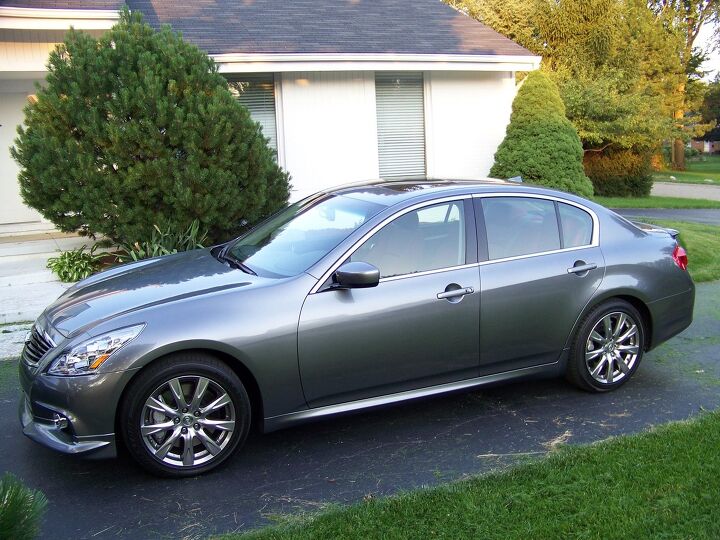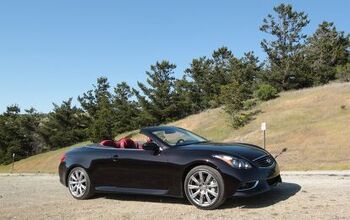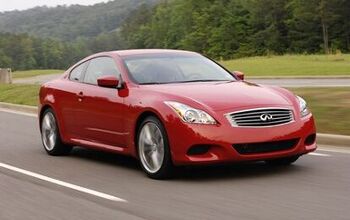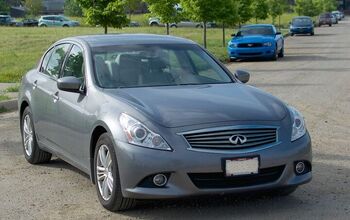Review: 2010 Infiniti G37 Anniversary Edition
Two decades have elapsed since rocks and trees went on TV to announce the birth of a new, proudly Japanese luxury car brand from Nissan. Infiniti somehow survived that car-free campaign and the (baker’s) dozen years of wandering in the desert that followed to finally enjoy some success with the 2003 G35. Sales might be off lately, but in light of the brand’s first 13 years and the entire industry’s last few years the mere act of survival merits a celebration. And what better way to celebrate than with special editions of the model that saved the brand (and that is currently most in need of a bump), recently renamed G37 to reflect an enlarged V6. Of course, some special editions are more special than others. Just how special is the G37 Anniversary Edition?
Sisters often don’t equally share in a family’s “assets.” In the Infiniti sedan family, the new 2011 M gets all of the lusty curves. Then again, one man’s “plain” might be another’s “clean.” The G37’s exterior is certainly clean, if less crisp than that of the original G35. The grille has avoided Audi’s influence and so
remains a reasonable size. Look closely and you might notice a distinctive shape and detailing inspired by Japanese swords. Too subtle when the competition seeks visual differentiation from a thousand feet? Or refreshingly subtle? The G’s “cab rearward” proportions have always been near perfect, with a lengthy dash-to-axle to proclaim that this ain’t no front-driver.
To this exterior the Anniversary Edition (AE henceforce) adds Graphite Shadow paint, nine-spoke alloys, a unique front chin spoiler, and a rear spoiler. Even if the paint was exclusive to this edition—and it’s not—there’s nothing special about dark gray metallic. The wheels, though attractive, have at least two spokes too many to appear sporty. Elegant, perhaps. But the spoilers, clashing with the otherwise clean lines, take the exterior in the other direction.
The interior makes more of a statement, with red leather seats exclusive to the AE. “Shodo” patterned aluminum trim, shared with the regular sedan, subtly maintains Infiniti’s position as the most overtly Japanese luxury car brand. The wood trim optional on other G37s is not available here. One artful touch: streets in the nav display appear hand-drawn. Aside from the red leather, though, the interior is standard G37. So the
materials are semi-premium and the lines are more practical than stylish. The lever to manually adjust the driver seat’s lumbar would seem less out of place in a Versa. The new M is a major step up in terms of both materials and style, which does much to justify its higher price.
Not that practical interior design is a bad thing. A major strength of the G37 sedan is that it simply feels right from the driver seat. The windshield isn’t overly distant or overly raked. By current standards the A-pillars are almost thin. The instrument panel, though larger and taller than in the original G35, isn’t overly massive or tall. The instrument cluster moves with the steering wheel, so the steering wheel can be relatively small without obstructing the gauges. The center stack’s controls are logically arranged within easy reach. All common sense, perhaps, but increasingly uncommon.
Car makers struggle over how aggressively to bolster seats. Enthusiasts want lateral support, but non-enthusiasts want ease of entry and exit. People come in different shapes and sizes. The
“obvious” but not common solution: adjustable bolsters. Infiniti goes half as far as BMW, fitting modestly sized but firm power-adjustable bolsters to the driver’s seat. If a bolster can be perfectly positioned, it doesn’t have to be terribly large.
Another piece of the G’s winning formula: an exterior length in between compact and intermediate. This permitted a few more inches of rear legroom than in the 2003 BMW 3-Series or Audi A4. The A4 is now nearly the same size, and the next 3 will follow suit, confirming that Infiniti found a happy medium. Want a car sized just large enough that the average adult can fit somewhat comfortably in back? This is it. Want a roomy, comfortable rear seat? Well, that’s another segment. The trunk is similarly “just enough.” A weakness: unlike in the Germans, a folding rear seat is not available.
The tweaked 350-horsepower V6 from the NISMO Z would have been welcome, if only to add some specialness, but the AE receives no powertrain tweaks. Worse, the 6-speed manual available on the regular G37 is not available here. The only powertrain option: a 328-horsepower 3.7-liter V6 paired with a manually-shiftable seven-speed automatic. The aging VQ isn’t the sweetest-sounding six, but its growl, suitably aggressive for this application, and nicely swelling torque curve as revs build encourage trips to the red line. Nissan paid a lot of attention to how this engine feels as revs climb, and it shows.
Infiniti’s seven-speed automatic isn’t the smoothest shifting, the quickest reacting, or the most intelligent. But this transmission has one clear strength: its first three gears are tightly spaced and significantly shorter than those in competing six-speed slushboxes. Corners taken in second in other cars are taken in third in this one. Unless it’s a tight corner, where other transmissions can fail to offer an appropriate ratio—first too low, second too high—and this one provides a short second. This gearing gives the already strong V6 a big boost at low speeds. There’s no soft spot as the engine gets from idle to its powerband. Thanks to this transmission it’s always already there. The transmission can be manually shifted via the paddles or the lever. But snick the lever to the left to engage sport mode and it generally maintains a sufficiently aggressive ratio all on its own.
The EPA rates the G37 19 city and 27 highway. You’ll match these figures only if you keep your foot out of the throttle, which isn’t easy.
The AE includes the G37’s Sport Package, with larger brake rotors (14.0” front, 13.8” rear), a sport suspension, low-profile performance tires, and a limited-slip rear differential, as standard equipment. The huge brakes fitted with the $370 R-Spec pads feel firm and strong without biting too quickly in
casual driving (a problem I’ve experienced with the compact Infiniti in the past). I did not go all Baruth on the brakes, though. No doubt Jack could (and would) fry them.
A possibly unwelcome bonus: the four-wheel-steering system (4WS) that used to be a $1,300 option on the G37 is for the 2010 model year only available, as a standard feature, on the AE. I say “possibly unwelcome” because I haven’t driven a G without this feature recently. Does it help, hurt, or not do much of anything? I’m afraid I cannot say. Owner opinions are, in their usual way, split. But including this system certainly bumps up the base price.
The standard G37’s steering ratio is a fairly quick 16.4:1. The Sport Package quickens this to 14.7:1. In addition to steering the rear wheels up to one degree in phase with the fronts, the 4WS includes an active variable steering ratio that ranges from 11.9:1 to 14.3:1. So the AE’s steering feels ultra-quick, right? No, not really. It feels quick and firm compared to the relaxed systems in domestic cars, but you’ll find quicker- and sharper-feeling steering in front-drivers like the Nissan Maxima and Acura TL—and in a 3-Series fitted with active steering. The 4WS might be a factor, since steering the rear wheels can effectively slow the steering ratio to 20:1. BMW’s active steering encompasses a similar range without involving the rear wheels, and its variation feels much more dramatic (not necessarily a good thing).
Whatever the cause, even with 4WS the G37 Infiniti steers close to conventional German steering systems, which avoid ultra-sharp steering reactions as they might lead to unplanned lane changes on the Autobahn. The G37 AE’s highway tracking is certainly relaxed, so 4WS seems to provide a benefit here. But in aggressive driving at moderate speeds the steering doesn’t quicken up and sharpen up as much as I’d personally prefer. The steering in the best German cars provides clearer feedback and makes corner carving more intuitive. With the G37, you receive more feedback through the seat of your pant than through your fingertips. The G37 also feels a little larger and heavier than the original G35, no doubt because it is a little larger and heavier, but also because of the usual sacrifices made in pursuit of refinement. Overall the G37’s steering is good but not great.
Even though the engine is positioned well rearward in a “front-mid” configuration, the G37’s weight distribution is a somewhat nose-heavy 54/46. This comes through in the handling, which is certainly more balanced than in a front-driver but retains a touch of understeer. Unless you get on the gas, in which case the car quickly transitions to severe oversteer. The limited-slip differential might play a role. Being able to steer a car with the throttle is a major benefit of rear-wheel-drive, but optimally the transition into oversteer can be gradually dialed in. Turn the G37’s stability control system off and you’d best be very careful as your right foot works its way up a definite learning curve.
Why turn the G37’s stability control system off? These days most such systems are virtually transparent in their operation. This isn’t one of them. The G37’s stability control cuts in early and aggressively. You don’t need the warning light to know when the safety nanny is cutting in. Why is this happening in a 2010 premium sedan? One suspicion: a quick-and-dirty fix for the tendency to sudden oversteer despite the fact that they’ve had years to sort the chassis out. Driving on unpaved roads suggests that winter driving would be…entertaining. It should go without saying that, for snow and ice, the standard summer tires should be replaced with winter treads.
The AE’s standard sport suspension is very firm, with the usual plusses and minuses. Body control is very good, with no slop in transitions, and the car is quite fun when rocketing along a curvy road. But settle back for a long, casual drive, and the suspension does not relax with you. There’s no bobbling about, but bumps tend to effect sharp vertical movements. The ride is often busy, and can lapse into harsh. Most enthusiasts will be willing to pay the price. Others will be unhappy.
Price has always been part of the appeal with the G. It has edged up over the last seven years, but remains considerably lower than the German competition. The AE might push some limits nevertheless. The Premium, Navigation, and Sport Packages are all standard, along with the spoilers and the 4WS. Infiniti has knocked off a few hundred dollars compared to where a G37 would
normally be with this level of equipment, but this still leaves $44,585. Whether or not this represents a good value depends on whether you’d check off the same boxes if you had a choice.
Ultimately, there’s one compelling reason to hunt down a remaining Anniversary Edition: the red leather. Want a manual transmission, or a more livable ride, or the lower price that attends fewer features? Perhaps the 4WS (which adds about $1,300) or the spoilers (which add nearly a grand) aren’t your cup of tea? Then that red leather will carry too high a price. Narrow market? Clearly, but then Infiniti only made 350 AE sedans.
Aside from the red leather, this special edition isn’t any more special than the regular G37. But then the G37 is a special car. The G35 saved Infiniti by combining a strong V6 and right-wheel-drive with the right size, the right price, and the promise of sub-Euro maintenance costs. Though the size and price have crept up a little with the G37, the G formula remains highly appealing.
Infiniti provided the vehicle, insurance and one tank of gas for this review
Michael Karesh owns and operates TrueDelta, an online source of automotive pricing and reliability data
Michael Karesh lives in West Bloomfield, Michigan, with his wife and three children. In 2003 he received a Ph.D. from the University of Chicago. While in Chicago he worked at the National Opinion Research Center, a leader in the field of survey research. For his doctoral thesis, he spent a year-and-a-half inside an automaker studying how and how well it understood consumers when developing new products. While pursuing the degree he taught consumer behavior and product development at Oakland University. Since 1999, he has contributed auto reviews to Epinions, where he is currently one of two people in charge of the autos section. Since earning the degree he has continued to care for his children (school, gymnastics, tae-kwan-do...) and write reviews for Epinions and, more recently, The Truth About Cars while developing TrueDelta, a vehicle reliability and price comparison site.
More by Michael Karesh
Latest Car Reviews
Read moreLatest Product Reviews
Read moreRecent Comments
- Legacygt It was more than 20 years ago that the Bangle designed BMW sedans started looking a little bit awkward. But the lineup today is chock full of downright ugly vehicles. This is one of them.
- Jeff It does state in this article that Europeans as well as Americans have cooled on EVs. I can see push back from consumers on the 2035 deadline for EVs in Europe and in states like California. I have no problem with manufacturers offering EVs but many for at least now don't want EVs. Maybe GM instead of planning to do away with the Malibu to make more EVs should have offered the Malibu as only a hybrid like Toyota is offering the Camry for 2025. It would cost GM a lot less to offer a hybrid Malibu and it would outsell any EV that plant would produce. I even think GM would increase sales of the Malibu as a hybrid only and more competitive pricing.
- Kwik_Shift_Pro4X I fell asleep looking at that image.
- Verbal Rented a Malibu a while back. It was fine, if a bit gutless.I get that Detroit wants to go all-in on high profit margin SUVs and blinged-out MAGA trucks. Everyone has known for decades that they can't compete on price in the affordable sedan space. So now all of Detroit's sedans are gone except for a couple of Cadillac models.But you'd think that just one of the domestic brands could produce a fun, competitive and affordable sedan. Just one? Please? Anyone? Bueller?
- 3-On-The-Tree I wouldn’t even use Ford as a hearse for fear of being late to my party.









































Comments
Join the conversation
I just purchased a 2010 G37 sedan. My last car was a 2004 G35 sedan. A few comments: 1. Out of 100 cars Infiniti sells, 40 are G37 sedans. It's their bread & butter. Yet it competes in one of the most competitive segments in the market. So you know Infiniti is putting its best foot forward with this car. They can't afford not to. 2. The price between similarly equipped 2004 and 2010 models did not materially change in 6 years. Yet the 2010 model is faster with more horsepower, 7AT v 5AT, better gas mileage, much better cabin technology, and roomier. Maybe I overpaid in 2004. Maybe I got a screaming deal in 2010. Either way, it reminds me of a real good home computer. Seems like it always costs about $2500, but you get more for your money year after year. 3. My 2010 version (non-sport, 17" tires) is much quieter, smoother over bumps, and gets better gas mileage. Road noise, feeling every bump and poor MPG were about the only things I got tired of in my 2004 G. 4. The VQ35 engine seemed "torquier", especially at the low end. The VQ37 on the other hand feels like my Dad's old 533i. When he bought that car in 1982, we were amazed because we'd always be surprised at how fast we were going when we looked at the speedometer. It just didn't feel like we were going that fast. I get a similar sensation with the G37. It's sneaky fast. 5. One of the things I liked about the G37 is that it was only about 1 inch longer and wider than than the G35. My garage is the same size it was in 2004. I guess I could have cleaned it out to make room for a larger sedan, but I appreciated the fact that Infiniti has resisted the urge to bloat the G. 6. Despite the same relative size, the cabin feels much roomier on the G37. I don't know how they did it. Visibility is awesome. 7. I can't fathom why any red-blooded male would pay $5K more for a 328i.
Infiniti is one of the only companies doing everything right. I would never buy a droll Nissan, but what they've been able to do with the G35/G37 is amazing. Beautiful and potent.